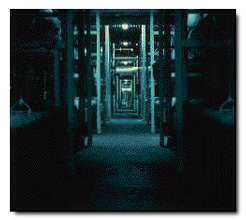Main Menu · Search · Current Issue · Contact · Archives · Centennial · Letters to the Editor · FAQs
 Sorting out MATEP's future under deregulation may be as complex as diagramming its pipes. |
![]()
Harvard has served as energy supplier to the medical community since 1906, when the medical school moved to its present Longwood Avenue site. To supply the new buildings with electricity and steam, the University built a powerhouse on Blackfan Street for $284,000. When commercial electrical power became available, the plant was devoted to supplying steam and chilled water, and was also expanded to serve the hospitals built nearby. But by the 1960s, the aging powerhouse was unable to meet the growing demands of the Longwood Medical Area buildings. The University therefore began planning for a new utility, which ultimately culminated in the launch of MATEP. (Harvard Magazine's July-August 1980 cover story reported MATEP's genesis in great detail.)
The facility Harvard ultimately built uses a highly efficient, interconnected system of generators, heat-recovery units, and electric and steam-turbine chillers. The six diesel-powered electrical generators are massive machines with cylinder heads three feet across; each is capable of producing 7,000 kilowatts. At peak output, the noise level inside the room--at 120 decibels--is literally deafening. When electricity is made by conventional means, a great deal of energy is wasted in the hot exhaust from burning fuel. Because MATEP uses that heat to produce steam, it captures 30 percent more energy per gallon of fuel oil than other electric plants in use across Massachusetts.
MATEP's customers--with over 9 million square feet of space in hospital rooms, laboratories, offices, and classrooms--use about 1 billion pounds of steam, 45 million "ton-hours" of chilled water for refrigeration (distributed through the buildings at 45 degrees Fahrenheit), and 225 million kilowatt hours of electricity annually. In all, more than 2,000 hospital rooms are served, accommodating 85,000 inpatients and 50,000 outpatients each year.
It's all a big leap from the humble 1906 Blackfan Street powerhouse. So is the MATEP website, "https://www.matep.com", which offers cybervisitors an electronic tour of the plant and details on the facility's pricing structure.
Main Menu ·
Search · Current Issue · Contact · Archives · Centennial · Letters to the Editor · FAQs
![]()